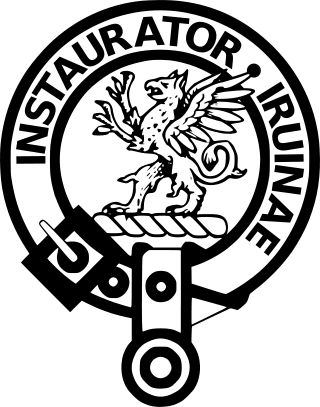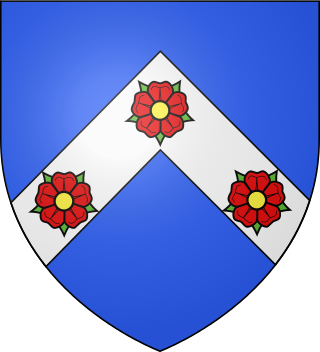
Clan Arbuthnott is a Lowland Scottish clan.

Clan Gordon is a Highland Scottish clan, historically one of the most powerful Scottish clans. The Gordon lands once spanned a large territory across the Highlands. Presently, Gordon is seated at Aboyne Castle, Aberdeenshire. The Chief of the clan is the Earl of Huntly, later the Marquess of Huntly.

Clan Hay is a Scottish clan of the Grampian region of Scotland that has played an important part in the history and politics of the country. Members of the clan are to be found in most parts of Scotland and in many other parts of the world. However, the North East of Scotland, i.e. Aberdeenshire (historic), Banffshire, Morayshire and Nairnshire Nairn (boundaries), is the heart of Hay country with other significant concentrations of Hays being found in Perthshire, especially around Perth, in the Scottish Borders, and in Shetland.

Clan Sutherland also known as House of Sutherland is a Highland Scottish clan whose traditional territory is the shire of Sutherland in the far north of Scotland. The chief of the clan was also the powerful Earl of Sutherland, however in the early 16th century this title passed through marriage to a younger son of the chief of Clan Gordon. The current chief is Alistair Sutherland who holds the title Earl of Sutherland.

Clan Nesbitt is a Scottish clan of the Scottish Borders that is recognised by the Lord Lyon King of Arms.

The House of Burnett is a Lowland and Border Scottish family composed of several branches. The Chief of the Name and Arms of Burnett is James Comyn Amherst Burnett of Leys.

Clan MacFarlane is a Highland Scottish clan. Descended from the medieval Earls of Lennox, the MacFarlanes occupied the land forming the western shore of Loch Lomond from Tarbet up-wards. From Loch Sloy, a small sheet of water near the foot of Ben Vorlich, they took their war cry of Loch Slòigh.

Clan Buchanan is a Highlands Scottish Clan whose origins are said to lie in the 1225 grant of lands on the eastern shore of Loch Lomond to clergyman Sir Absalon of Buchanan by the Earl of Lennox.

Clan Forsyth is a Scottish clan.

Clan Home is a Scottish clan. It held immense power for much of the Middle Ages and dominated the eastern Scottish Borders. It produced no fewer than eight Wardens of the Eastern March – more than any other family.
Clan Strachan is a Scottish clan originating from the barony of Strachan, in Aberdeenshire. The clan does not have a chief, therefore it is considered by Court of the Lord Lyon and the Stand Council of Scottish Chiefs as an Armigerous clan.

Clan Swinton is a Scottish clan of the Scottish Lowlands.

Clan Muir is a Scottish clan that is armigerous. Historically, holders of the surname Muir can be considered septs of Clan Campbell and Moir are the septs of Clan Gordon in the highlands. The spelling variation More/Moore is a sept of Clan Leslie in Aberdeenshire. Some members of Clan Muir who trace their ancestry to Ayrshire are septs of Clan Boyd. A single family, the Mores/Moores of Drumcork, are septs of Clan Grant.
Johnston is in most cases a habitational surname derived from several places in Scotland. Historically, the surname has been most common throughout Scotland and Ireland.

Clan Blackadder is a Scottish clan. The clan historically held lands near the Anglo-Scottish border.

Clan Gardyne is a lowland Scottish clan from Angus. The clan does currently have a chief, Samuel Edward Britton Gardyne recognised by the Court of the Lord Lyon, therefore it is considered an clan. With the clan spreading as far as New Zealand. Where the current chief lives.

Clan Russell is a Scottish armigerous clan, with claimed origins in Normandy. It has ancestral ties to the English Dukes of Bedford, and has numerous descendants in Great Britain and America.

Clan Cheyne is a Scottish clan. The clan is officially recognized by the Lord Lyon King of Arms, however as the clan does not currently have a chief recognized by the Court of the Lord Lyon, it is therefore considered an Armigerous clan. The surname Cheyne is also recognized as a sept of the Clan Sutherland, and is accepted as such by the Clan Sutherland Society in Scotland.
James Hardy LL.D. was a Scottish naturalist and antiquarian. He was secretary of the Berwickshire Naturalists' Club from 1871 until at least 1896. At least two species have been named in his honour.

The Feudal Barony of MacDuff is a Scottish Feudal Barony in Macduff, Scotland, contained mostly within the boundaries of the Town of Macduff, in the Banff and Buchan area of Aberdeenshire, Scotland. Clan MacDuff traces origins to the historic, Lowland, Scottish Duff Clan. William Shakespeare's MacBeth has always played a role in the legend of Clan MacDuff, as few can determine the line between The Duff Family history and historical fiction. This ambiguity worked to the benefit of future MacDuff Barons, who were able to prove they were descended from the first Duff to receive a charter in Northeast Scotland. In 1404 David Duff received the charter, in Aberdeenshire, from Robert III of Scotland. In 1759, William Duff was granted the historic Celtic Title of “Fife”, further tying the Duffs of Northeast Scotland, with their ancient Lowland ancestors - the original Earls of Fife from the 11th century. William Duff had five sons - the eldest, James, would become the 2nd Earl Fife and the 1st Baron of MacDuff. James invested heavily in the village of Doune, or “Down”, across the River Deveron from Banff. He built a harbor there in 1760, which quickly became more successful than the harbor at neighboring Banff, which had been established much earlier. In 1783 a charter was granted by King George III, changing the name from Doune to Macduff in his favor and, although a lesser title than Earl, bestowing on him the dignity of the 1st Baron of Macduff.